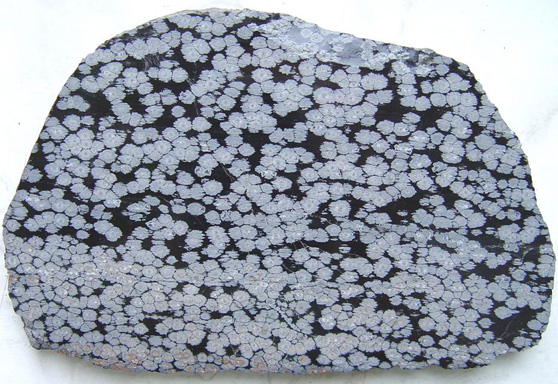Snowflake Obsidian
Snowflake Obsidian is a type of obsidian which, rather than being pure black, has patches of white coloration that look like snowflakes. The snowflakes are formed from radial crystals of cristobalite, a variety of quartz with a different structure. [1] Some specimens exhibit more "snow" than others and the amount seems to be random - from a few flakes to a blizzard...

Snowflake Obsidian
A pig carved from Snowflake Obsidian
Snowflake obsidian is typically carved and polished into shapes in order best to display its coloration, and it is common to see snowflake obsidian spheres, eggs, hearts, pyramids, cabochons, beads and carved objects from animals to miniature lidded jewelry boxes.
Snowflake obsidian is often set into rings, pendants and other forms of jewelry (most commonly silver but also occasionally gold) and these may be very affordable. As snowflake obsidian is not scarce, it is not likely that forgeries will be found.
The term snowflake obsidian seems to be recent, and does not make its entry into popular culture until the 1940's, where it begins to appear in mining / mineralogical publications, where finds in the USA are described. Snowflake obsidian has also been called Flowering Obsidian or Spherulitic Obsidian. The latter of these terms is older; appearing for example in Bernhard von Cotta's 1866 "Rocks Classified and Described: A Treatise on Lithology" and beginning to surface in other geological documents of the 1860's and 1870's. The term "spherulitic Obsidian" seems to have fallen from popular use.
Snowflake Obsidian Occurrence
Obsidian is widespread, however the Mindat database only lists one location for snowflake obsidian - Black Rock, Milford, Utah in the USA. (Not to be confused with the Black Rock Desert in the neighboring state of Nevada!) [3] Walter Schumann's "Gemstones of the World" book also lists Mexico as a source for snowflake obsidian. [4]
A rare variety with red "snowflakes" or "spherulites" has also been found. [2]
Note - the greatest caution should be exercised if obsidian objects of any kind are broken or have broken or oblique edges; obsidian is a type of glass and can often be truly sharper than a razor. Disclaimer - this is not medical advice.

Snowflake Obsidian
Snowflake Obsidian - Sources Referenced:
[1] http://en.wikipedia.org/wiki/Obsidian
[2] http://www.cst.cmich.edu/users/dietr1rv/obsidian.htm
[3] http://www.mindat.org/min-8520.html
[4] Schumann - "Gemstones of the World", p.246
Back to the Gemstones List home page - over 160 gemstones explored!
Please feel free to link to this page - copy / paste the text below: (click to select)
Privacy Policy | Cookie Policy | GDPR | About This Site / Terms

© gemstoneslist.com


